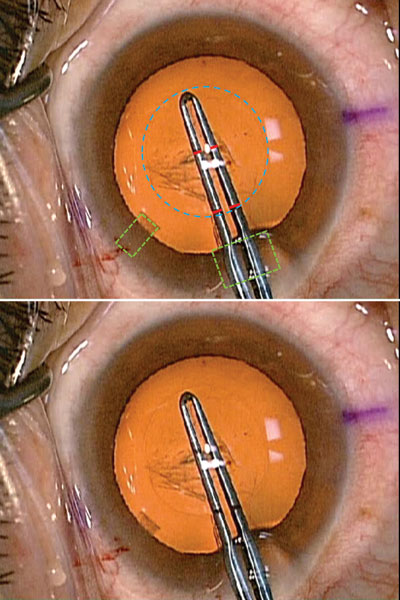The golden rule of cataract surgery
Surgeons should deliver the same high level of care that they would want for their own eyes.
 Uday Devgan |
Elementary school children learn the golden rule of treating others the way that they would like to be treated. The same logic applies to surgery: We should deliver the same high level of cataract surgery that we would want for our own eyes. Cataract surgery will permanently affect the way that the patient sees, every waking moment, forever. Our goal is to deliver a safe and efficient surgery with precise and predictable results. I recently had the pleasure of performing cataract surgery for a good friend who has been in ophthalmology for 30 years, and I will use his case to show how we can put the steps together to deliver the best possible results.
Preoperative evaluation
Biometry is critical to ensure accurate lens calculations, but care should also be taken to examine the rest of the eye in detail. In this case, the patient had a history of high myopia, and a detailed posterior segment examination showed a normal retina without evidence of pre-existing pathology. The anterior segment exam showed nuclear sclerotic changes, a normal cornea and a healthy tear film. The axial length and keratometry measurements were used to perform the lens calculations with multiple formulae, with more weight given to the SRK/T, Holladay 2 and Haigis because they tend to be more accurate in these myopic eyes. The patient was noted to have a mild amount of against-the-rule corneal astigmatism. The IOL power was selected based upon the patient’s desired refractive result and the personalized A-constant from the surgeon’s experience.
Intraoperative techniques
The first step of any successful surgery is proper draping and preparation to allow for exposure and access and to decrease the risk of infection. For cataract surgery, this includes a sterile plastic adhesive barrier to keep the lashes and the eyelid margin away from the surgical field because this is the most common source of pathogens. Incisions that seal well are also important to minimize the risk of infections and other postoperative complications.
Clear corneal incisions should have a sufficiently long tunnel length and intersect the limbal vessels. Diamond keratomes are ideal because they have an unparalleled level of sharpness and control that allows consistency. In this case, the incision was placed on the steep corneal axis to address the pre-existing corneal astigmatism.
In order to have a predictable effective lens position, the capsulorrhexis should be 5 mm in diameter so that it overlaps the 6-mm optic for a full 360°. It is centered on the pupil or visual axis, which both tend to be more nasal than the center of the cornea or capsular bag. My forceps are marked at 2.5 mm and 5 mm from the tip to show me the ideal radius (2.5 mm) and diameter (5 mm) of the capsulorrhexis. A blunt 27-gauge cannula is used to perform hydrodissection and hydrodelineation, and additional dispersive viscoelastic is used to coat the corneal endothelium.
|
Image: Devgan U |
For my preferred technique of phaco chop, appropriate fluidic and power modulation parameters were chosen. A higher vacuum level allows for a solid purchase on the nucleus, and a moderate flow rate helps aspiration of cataract fragments. Burst and pulse modes allow the surgeon to minimize the ultrasonic energy and prevent heat buildup at the phaco tip. When the last nuclear piece is being aspirated, the blunt back surface of the chopper is used to form an additional barrier to protect the posterior capsule. A silicone-coated irrigation and aspiration tip is used to remove the lens cortex and clean the capsular bag from lens epithelial cells.
The lens implant is placed in the capsular bag and rotated to ensure that both haptics and the optic are appropriately positioned. After the viscoelastic is removed from behind the lens, the optic is centered securely under the capsulorrhexis edge. The incisions are hydrated with balanced salt solution and checked for water-tightness.
Postoperative management
The patient was watched closely in the postoperative period and placed on a medication regimen of antibiotics, NSAIDs and steroids to modulate healing. Inflammation was quickly resolved, and stability of the incisions was achieved. As the capsular bag contracts, it will cause the IOL to shift slightly until it reaches its final position and refractive result.
While this is currently the state of the art in cataract surgery, as ophthalmology evolves, our instrumentation and techniques will continue to improve. We are now seeing the first femtosecond lasers for cataract surgery, which promise to bring increased accuracy to the creation of incisions and the capsulorrhexis. Future lens implants may offer true accommodation and eliminate the issue of posterior capsule opacification. But there will be one constant in the way that I perform cataract surgery: I will always deliver the same high level of care that I would want for my own eyes.

- Uday Devgan, MD, FACS, FRCS(Glasg), is in private practice at Devgan Eye Surgery in Los Angeles, Beverly Hills and Newport Beach, Calif. He is also chief of ophthalmology at Olive View UCLA Medical Center and associate clinical professor at the UCLA School of Medicine. He can be reached at 11600 Wilshire Blvd., Suite 200, Los Angeles, CA 90025; 800-337-1969; fax 310-388-3028; e-mail: devgan@gmail.com; website: www.devganeye.com.
- Disclosure: No products or companies are mentioned that would require financial disclosure.










